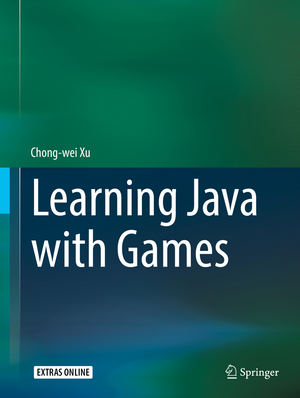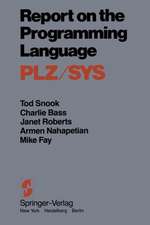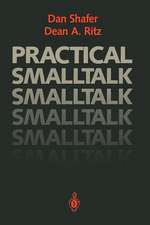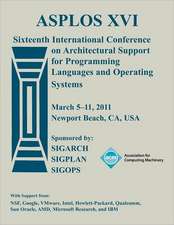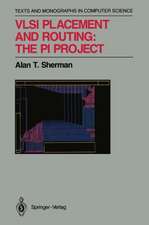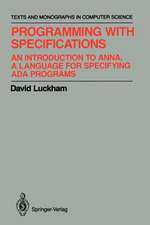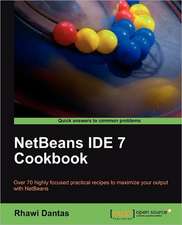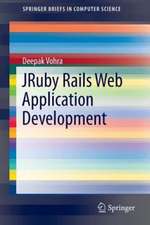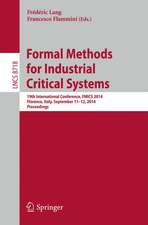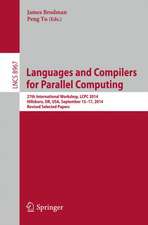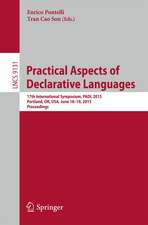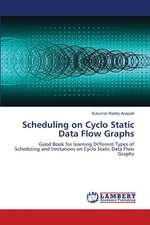Learning Java with Games
Autor Chong-wei Xuen Limba Engleză Hardback – 27 noi 2018
Instead of teaching game design using Java, projects are designed to teach Java in a problem-solving approach that is both a fun and effective. Learning Java with Games introduces the concepts of Java and coding; then uses a project to emphasize those ideas. It does not treat the object-oriented and procedure and loop parts of Java as two separate entities to be covered separately, but interweaves the two concepts so the students get a better picture of what Java is.
After studying a rich set of projects, the book turns to build up a “Three-layer Structure for Games” as an architecture template and a guiding line for designing and developing video games. The proposed three-layer architecture not only merges essential Java object-oriented features but also addresses loosely coupled software architecture.
Preț: 474.62 lei
Preț vechi: 593.27 lei
-20% Nou
Puncte Express: 712
Preț estimativ în valută:
90.83€ • 94.25$ • 75.92£
90.83€ • 94.25$ • 75.92£
Carte tipărită la comandă
Livrare economică 13-19 martie
Preluare comenzi: 021 569.72.76
Specificații
ISBN-13: 9783319728858
ISBN-10: 3319728857
Pagini: 474
Ilustrații: XXIV, 563 p. 151 illus., 112 illus. in color.
Dimensiuni: 210 x 279 x 32 mm
Greutate: 1.72 kg
Ediția:1st ed. 2018
Editura: Springer International Publishing
Colecția Springer
Locul publicării:Cham, Switzerland
ISBN-10: 3319728857
Pagini: 474
Ilustrații: XXIV, 563 p. 151 illus., 112 illus. in color.
Dimensiuni: 210 x 279 x 32 mm
Greutate: 1.72 kg
Ediția:1st ed. 2018
Editura: Springer International Publishing
Colecția Springer
Locul publicării:Cham, Switzerland
Cuprins
1 Java programming and game development: a project HelloWorld
2 Basics of Java programming: a project PrintXmasCard
3 Java operators: a game GuessInt in text
4 UML and its usage: a game WheelFortune in text
5 GUI programming with graphical drawing: a project PaintXmasCard
6 Software components and event handling: projects CalculatorApp and ImageSlider
7 Event driven: a game Anagram in text
8 Event driven with an update-paint chain: a game Blackjack
9 Key control: a game Sudoku
10 Mouse control: a game Agnes
11 Animation programming: a digital clock and an analog clock
12 Merge visualization, event-driven, and animation: a game WheelVideo
13 Animated sprites and collisions: a game Pong
14 Multiple screens: an extension of the game Pong
15 A three-layer software structure for games: a game PongStruTwo
16 Usage of the framework: projects SymBall and Tornado
17 Image sprite and UML state machine: a game Breakout
18 Sound effect and composite class: enriching the game Breakout
19 Dynamically changed sprite’s structure: a game Worm
20 Chess-like game: a game Othello
21 An introduction of artificial intelligence: extensions of the game Othello
22 Visualizing array sorting algorithms
23 Animating conversions between binary and decimal
24 Animating binary arithmetic computations
Appendix A: References
Appendix B: The three-layer software structure for games
3 Java operators: a game GuessInt in text
4 UML and its usage: a game WheelFortune in text
5 GUI programming with graphical drawing: a project PaintXmasCard
6 Software components and event handling: projects CalculatorApp and ImageSlider
7 Event driven: a game Anagram in text
8 Event driven with an update-paint chain: a game Blackjack
9 Key control: a game Sudoku
10 Mouse control: a game Agnes
11 Animation programming: a digital clock and an analog clock
12 Merge visualization, event-driven, and animation: a game WheelVideo
13 Animated sprites and collisions: a game Pong
14 Multiple screens: an extension of the game Pong
15 A three-layer software structure for games: a game PongStruTwo
16 Usage of the framework: projects SymBall and Tornado
17 Image sprite and UML state machine: a game Breakout
18 Sound effect and composite class: enriching the game Breakout
19 Dynamically changed sprite’s structure: a game Worm
20 Chess-like game: a game Othello
21 An introduction of artificial intelligence: extensions of the game Othello
22 Visualizing array sorting algorithms
23 Animating conversions between binary and decimal
24 Animating binary arithmetic computations
Appendix A: References
Appendix B: The three-layer software structure for games
Notă biografică
Chong-wei Xu is Emeritus Professor in the Department of Computer Science at Kennesaw State University, USA. He obtained his master degree from University of Wisconsin-Madison and his Ph.D degree from Michigan State University. His research interests include Parallel Computing, Internet Technology, and Video Game Construction.
Caracteristici
Games classified into text-based, event-driven based, and sprite-animation based, so that every game could be incrementally built up Lets teachers and students easily recognize and schedule their projects. The Java language elements are introduced accordingly, from static to dynamic The reader will learn how to analyze a real world application and how to apply Java language to solve real world problems During implementation, students will immediately see the effects of their programming effort, making learning interesting and engaging Term projects and working teams can be easily formed Teaching resources, including answers to exercises and online coding resource where any student who wants additional practice can try coding questions based on the book material
